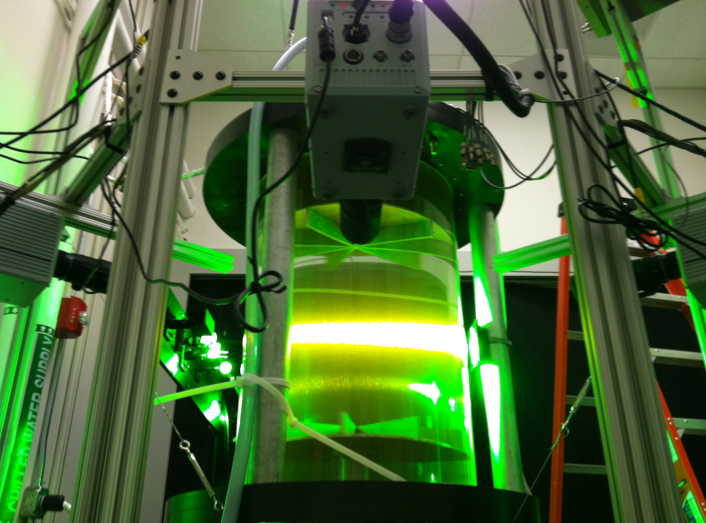Research
Turbulence in Complex Fluids

In a simple, Newtonian fluid (like water or air), stress is linearly proportional to strain rate; the coefficient of proportionality is the viscosity. But when the fluid has mesoscale structure, like, for example, a polymer solution or a colloidal suspension, this simple relationship breaks down, and the rheology can change significantly. Such materials are known as complex fluids.
We are interested in turbulence in dilute solutions of long-chain polymers in water. It has been known since the 1940s that polymers added to a turbulent wall-bounded flow can reduce the drag at the boundaries by up to 80%. Polymers also, though, have an effect on turbulence far away from any boundary, though exactly how they affect the turbulence is not fully clear.

Long-chain polymers behave like springs: they can store elastic potential energy by stretching, and release it again when they contract. In a turbulent flow, the polymer molecules are constantly stretching and relaxing. In the process, they draw energy out of the turbulence, and dissipate it again at small scales. Polymers therefore appear to disrupt the energy cascade. We have also found that polymer concentration plays an important role in their effect on the turbulence. We have identified a critical concentration (of about 5 parts per million by weight, for the polymer we used) below which the statisics look like those of a Newtonian fluid at intermediate length scales, and above which they do not.
Our current efforts are aimed at understanding the exact ways in which the polymers modify the turbulent energy cascade far from boundaries. Answering these questions will allow us to pinpoint the effect of the wall in friction drag reduction, and to understand how polymers or other complex fluids may be able to modify other kinds of drag in practical, engineering flows.
Representative Publications
N. T. Ouellette, H. Xu, and E. Bodenschatz, "Bulk turbulence in dilute polymer solutions," J. Fluid Mech. 629, 375-385 (2009).
A. de Chaumont Quitry and N. T. Ouellette, "Concentration effects on turbulence in dilute polymer solutions far from walls," Phys. Rev. E 93, 063116 (2016).